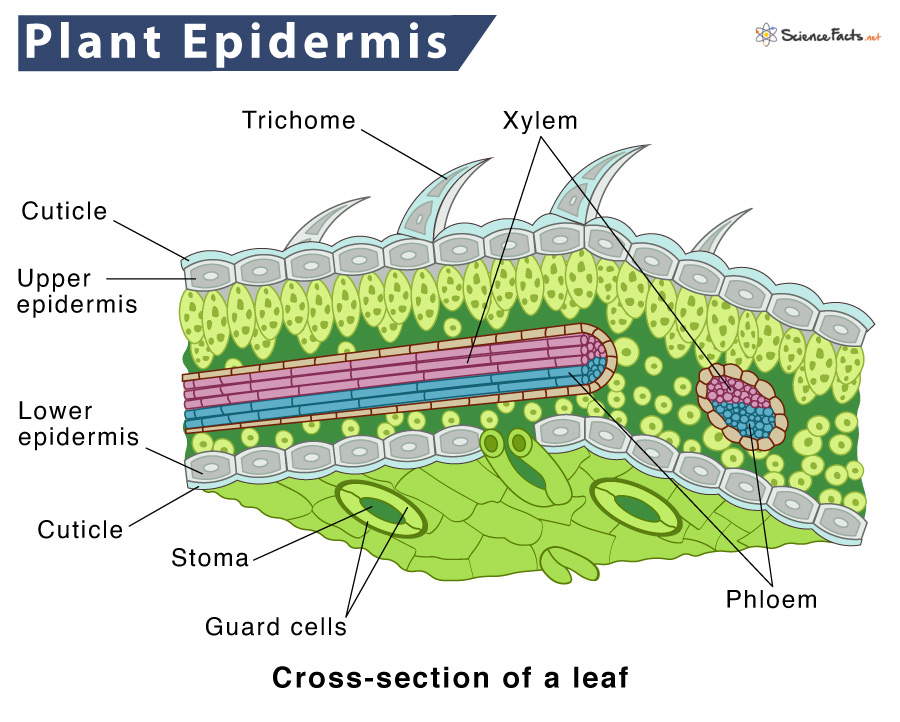Epidermis in Plants
Just like animals have skin, the outermost layers of leaves, flowers, roots, and stems of plants are covered by a layer of tightly packed cells called the epidermis. The cells that form the epidermis are called epidermal cells. The epidermis is a part of the dermal tissue system, acting as the first line of defense against any physical damage and microbial infection.
Structure: What is Epidermis Made of
Plant epidermis consists of four types of cells: 1) pavement cells, 2) guard cells, 3) trichomes, and 4) cuticles. These cells form the upper and lower epidermis layers. In between these two layers lie the two other essential plant tissue systems – the ground tissue and vascular tissue (xylem and phloem) that carries out basic metabolic activities and transportation of water and nutrients, respectively.
1) Pavement Cells
The outer region of the epidermis layer is made up of pavement cells. These are the most commonly occurring epidermal cells, lacking any characteristic shape. Under the influence of the cell cytoskeleton and some specific cellular proteins, the morphology of pavement cells varies from organ to organ, or in between different plant species.
For instance, in dicot leaves, the shape resembles interlocking jigsaw puzzle pieces to form a sturdy layer, providing mechanical strength to the leaves. On the contrary, the pavement cells found in the stem and various elongated plant organs have a rectangular shape with a long axis that is parallel to the direction of expansion of the stem, or that organ.
Functions
- Form a protective layer for the cells lying underneath.
- Prevent excess water loss.
- Keep the inner layers of cells in place.
- Help maintain the internal temperature.
- Resist the intrusion of any outside particles or pathogen.
- Keep the stomata apart by providing tension on both sides. There is at least one pavement cell between each stoma.
2) Guard Cells in Stomata
Another component of the epidermis, the guard cells, are two bean-shaped, chlorophyll-containing cells surrounding each stoma. Unlike pavement cells, these cells have a definitive shape. However, the spatial arrangement of these cells depends not only on size but also on the shape of the air-space below them.
Depending on the concentration of water vapor, sugars and ions, these guard cells become turgid or flaccid, thus aiding in the opening or closing of the stomatal pore. When water enters the guard cell, they become turgid, thus closing the stoma and vice versa. The closing and opening of these stomatal pores also regulate the gaseous exchange in and out of the leaves during respiration and photosynthesis.
Functions
- Regulate the closing and opening of stomata, thus aiding in gaseous exchange.
- Help in photosynthesis.
3) Trichomes
Trichomes, also known as epidermal hairs, are tiny hair-like structures located on the outermost region of the epidermis. The epidermis of petals forms a variation of trichomes called conical cells.
Functions
- Protect plants from predators and pathogens by either trapping or poisoning them.
- Shield inner tissues of leaves.
4) Cuticle
The outer surface of epidermal cells has a waxy coating called the cuticle. It is made up of cutin, a polymerized ester of fatty acids. Being waxy, it acts as a water-repellent, adds shine, and helps reflect excess sunlight. The thickness of this coating largely depends on the type and location of the plant.
Functions
- Protects plants against drought, extreme temperatures, UV radiation, chemical attack, mechanical injuries, and pathogen or pest infection.
Why is Epidermis Important for the Plants
- Protects internal tissues from any mechanical shock or injury.
- Minimizes water loss, keeping plants from drying out.
- Aids in the process of gaseous exchange during transpiration, photosynthesis, and respiration.
- Secretes metabolic compounds.
- Helps in the absorption of water and essential minerals.
- Protect plants from predators and parasitic attacks.
-
References
Article was last reviewed on Wednesday, April 13, 2022




